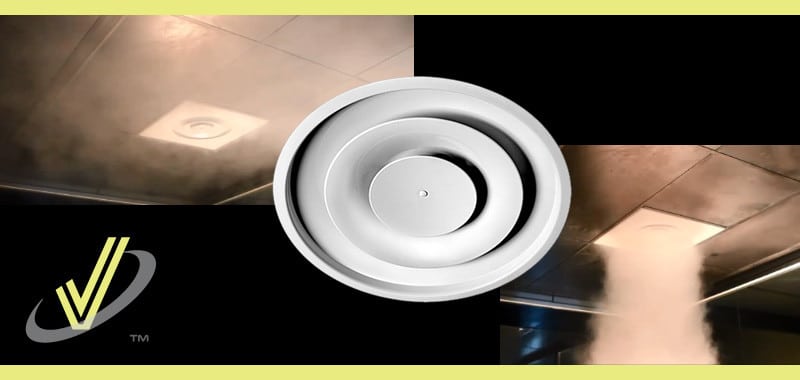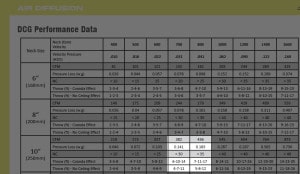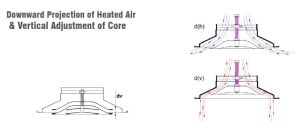
Most large commercial air distribution manufacturers have their particular ceiling round diffuser model. Although some have fixed air patterns while others are adjustable, they all look very similar to one another.
EffectiV HVAC is a line of specialty diffusers only. Each product addresses special architectural, comfort and energy efficiency needs. Therefore, we often respond to the question: Why the DCG? Alright, it’s all aluminum, it’s adjustable, and it’s one of the best looking round diffusers out there. But still, what makes it so unique?
The answer is performance! DCG has a high level of adjustability. Like all standard adjustable round diffusers, DCG allows for a vertical adjustment of the airflow. But thanks to the well-engineered design, the DCG can be gradually adjusted from a full horizontal airflow to a downward vertical blast.
In air conditioning and ventilation modes, the DCG round diffuser can be adjusted in horizontal mode to supply fresh air in 360 degrees airflow, while leveraging the Coanda effect when installed in closed ceilings.
In addition, while in in heating mode, the DCG can be adjusted to send the air downward in a more vertical jet. The DCG’s jet in full vertical mode can ensure heating comfort even when installed in very high ceilings.
Moreover, DCG’s airflow is adjusted by rotating the core clockwise or counter-clockwise, moving it up or down. Therefore any level vertical adjustment is available in order to optimize occupants’ level of comfort.
A Closer Look into DCG’s Performance
Let’s analyze the DCG’s performance using a simple example. Let’s take the DCG for a 10 inches duct diameter supplying 400 cfm of isothermal air. The data below is for a full horizontal adjustment of the core.
As shown in the image above, the performance table shows values for 382 cfm and 436 cfm. We can use both values and extrapolate values in between them. In order to extrapolate a discrete value, we assume that we are dealing with linear curves. It is a safe assumption given the small portion of data analyzed. The difference between 400 cfm and our two listed values is respectively 18 cfm and 36 cfm. Therefore, we will use a 2/3 – 1/3 ratio to extrapolate.
For instance, we know that the pressure loss will be between 0.141 and 0.183 w.g. Using the formula:
Extrapolated Value = (2/3 * Value 1) + (1/3 * Value 2)
We get:
Pressure Loss = 2/3 x 0.141 + 1/3 * 0.183 = 0.155 w.g.
Using the same formula, we get throw values of:
Throw (ft) Coanda Effect: 6 – 10 – 15
Throw (ft) No Ceiling Effect: 4 – 7 – 11
NC is close to 30
A few remarks regarding throw values.
- We publish both values for installation into closed ceilings or open duct. In a closed ceiling, the Coanda effect will significantly extend the throw.
- Contrarily to AHRI standard which measures throw values at terminal velocities of respectively 150 fpm, 100 fpm and 50 fpm, European certifications calculate throw values for terminal velocities of respectively 100 fpm, 60 fpm and 40 fpm. Which one is better will be left for another debate, yet it is important to be aware of this fact when selecting the product.
For the sake of the example, we have to stay as generic as possible. A study from ASHRAE shows that, in the neck region, the percentage of complaints are significant at and above 50 fpm. This number will obviously be affected by air temperature and turbulence. One thing that’s interesting with the European standard throw values is that we can use a 60 fpm terminal velocity in heating and 40 fpm in air conditioning to measure comfortable throw values.
In our example, the DCG 10″ supplying 400 cfm of isothermal air in its horizontal adjustment will reach terminal velocities of:
- 60 fpm at a distance of 10 feet from the diffuser in closed ceilings
- 40 fpm at a distance of 15 feet from the diffuser in closed ceilings
- 60 fpm at a distance of 7 feet from the diffuser in open ceilings
- 40 fpm at a distance of 11 feet from the diffuser in open ceilings
Heating Mode and Vertical Adjustment
We use a different table for downward projection of heated air:
This table shows throw values for three different vertical adjustments.
What about air temperature? Again, it is very important to read the performance notes:
In the above table, the three vertical throw values are not for different terminal velocities. They are all measured at a 40 fpm terminal velocity. The three throw values are for three different temperature differences (delta T): isothermal, 9°F and 18°F.
Depending on the adjustment of the core, if for instance we supply air at a temperature of 74°F into a 65°F room (delta T 9°F), we will reach 40 fpm terminal velocities at respectively 9, 13 and 16 feet from the diffuser.
Now that you are familiar with the DCG’s performance data and selection process, let’s get back to this article’s main topic:
Is DCG the most adjustable commercial round ceiling diffuser?
Analyzing DCG’s isothermal performance and throws for 40 fpm terminal velocities, we get the following result for the 10″ neck diameter at 400 cfm:
- Full horizontal mode with ceiling effect: 15 feet horizontal throw
- Full vertical mode: 32 feet vertical throw
These are extreme numbers. However, keep in mind that DCG’s adjustment is continuous and any desired throw in-between those values can be obtained.
Note: DCG is all about vertical adjustment of the airflow. If you are interested in horizontal adjustment instead, check out our PLAY-C adjustable sectors round diffuser. PLAY is the only air diffuser in the market allowing for a full 360 degrees horizontal adjustment of the airflow. You might also be interested in this article: Improving Both Comfort and Energy Efficiency with a Single Diffuser?







